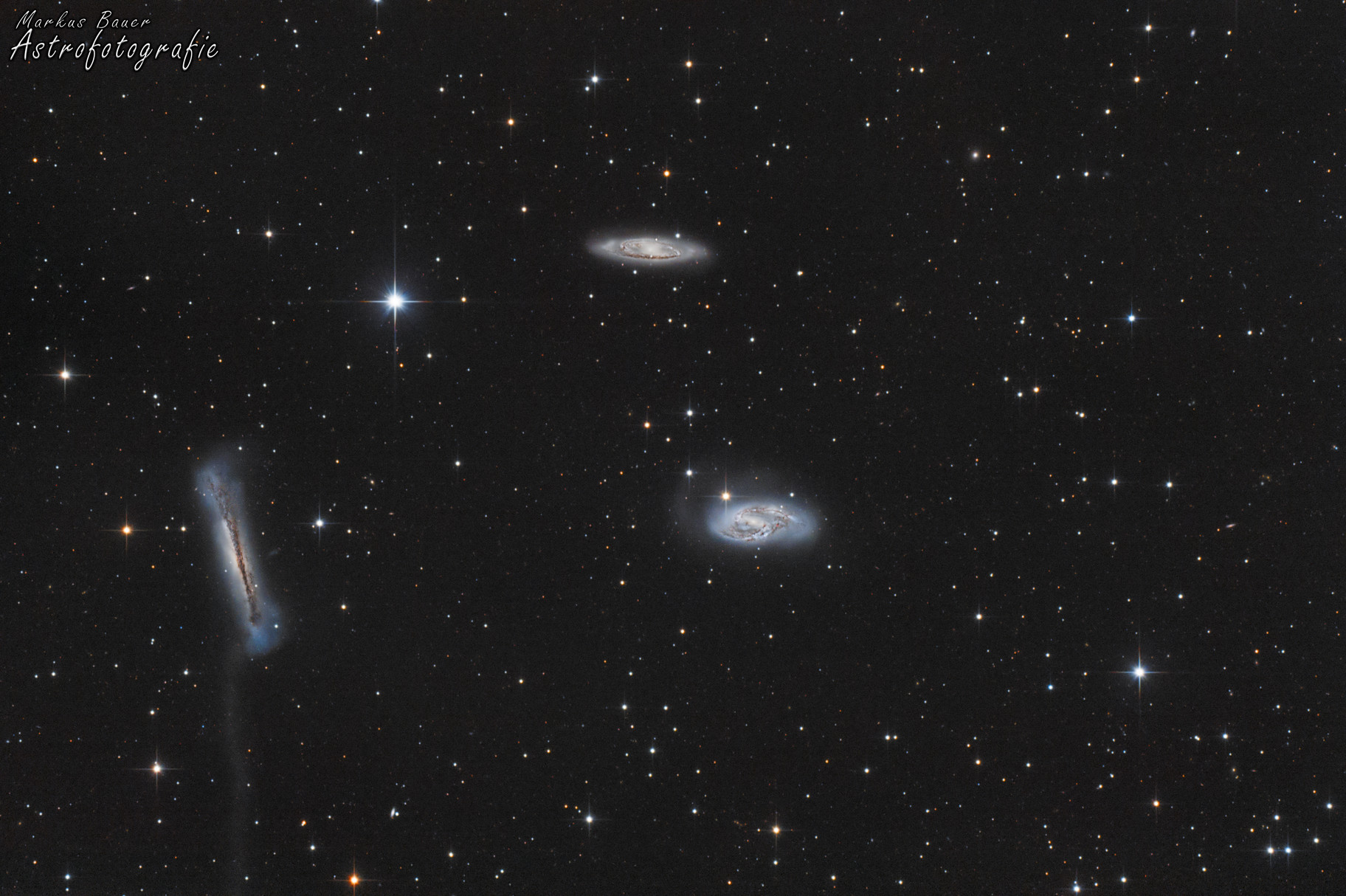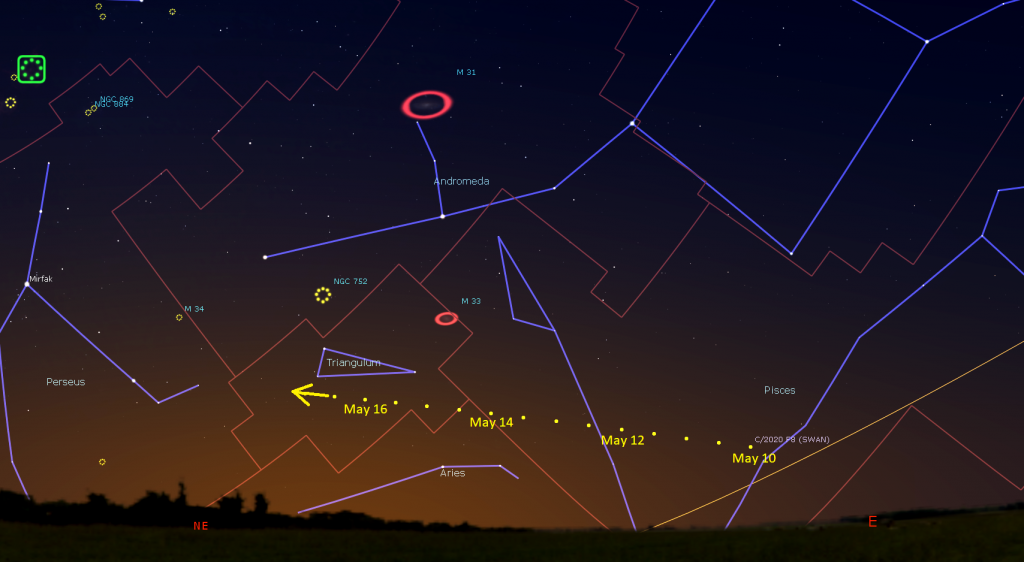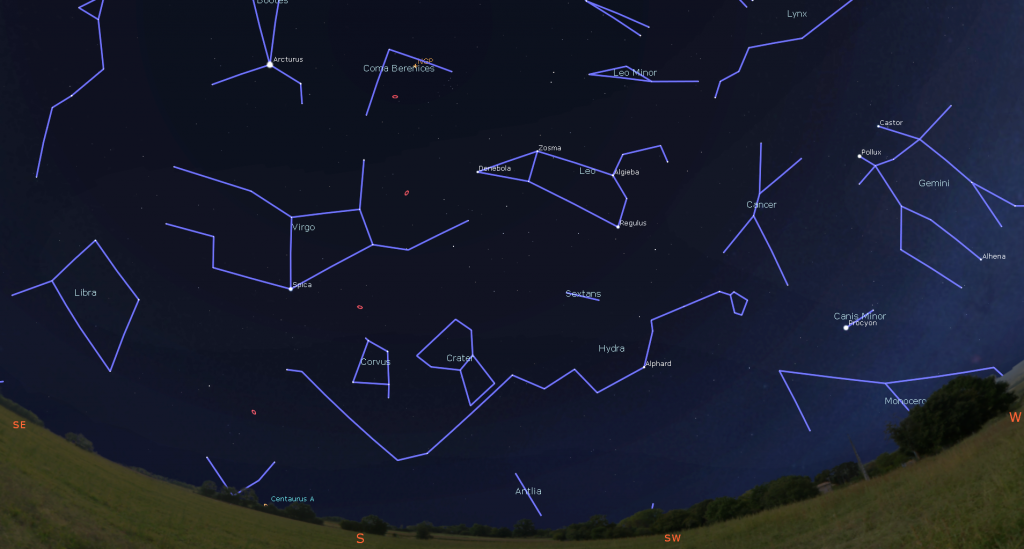Mercury Joins Evening Venus, the Old Moon Moves Past Pre-dawn Planets, and Dark Night Skies Bring Galaxies Galore!

This image of the LeoTrio of Galaxies was captured by Marcus Bauer. It was a NASA APOD for April 18, 2019. Top to bottom, the image spans one degree of the sky. The Hamburger Galaxy (NGC 3628) is at centre left. M65 is at top centre and M66 is at centre right.
Happy Mother’s Day!
Here are your Astronomy Skylights for the week of May 10th, 2020 by Chris Vaughan. Feel free to pass this along to your friends and send me your comments, questions, and suggested topics. You can also follow me on Twitter as @astrogeoguy! Unless otherwise noted, all times are expressed in Eastern Time. To subscribe to these emails please click this MailChimp link.
I can bring my Digital Starlab portable inflatable planetarium to your school or other daytime or evening event, or teach a session online. Contact me through AstroGeo.ca, and we’ll tour the Universe or the Earth’s interior together!
Comet SWAN has reportedly started to fizzle – but it’s still bright enough to see with unaided eyes, especially if you live at a southerly latitude. The moon will tour the bright planets in the eastern pre-dawn sky, and its absence from the night-time sky all over the world this week will make it dark enough to see galaxies. Brilliant Venus continues to show a pretty crescent in telescopes after dinner, while Mercury climbs to greet it. Here are your Skylights!
Bright Comet SWAN Update
A comet named c/2020 F8 (SWAN) has become bright enough to see with unaided eyes (about magnitude of +5.5)! But its orbit is keeping it too low in the sky and too close to the sun for easy viewing by people living at mid-northerly latitudes.
Unfortunately, the comet suddenly dropped in brightness last week – a sign it may be disintegrating as it feels the heat of the sun. It is still bright enough to see in binoculars and backyard telescopes, though – especially by people who live at low northerly latitudes and farther south. On May 12 Comet Swan will make its closest approach to Earth of 0.56 Astronomical Units (that’s about 84 million km, or half the average sun-Earth distance). It is predicted to reach peak brightness around May 27 when it swings around the sun at perihelion.

Look for Comet SWAN sitting low in the eastern pre-dawn sky at around 5 am local time. This week it will travel east through the “V” of Pisces (the Fishes) and then below (south of) the constellation Triangulum (the Triangle). If you live farther south, you’ll have a much easier time seeing it as a greenish fuzzy patch with a faint narrow tail.
I posted a sky chart here showing its path over the month of May.
The Moon and Planets
This week the moon will rise later at night and linger into the morning daytime sky while it wanes in phase. This will also be the week of the month when the moon tours the string of bright planets that are gathered low in the eastern pre-dawn sky along the ecliptic – making a fantastic viewing and photo opportunity for early risers!
When the gibbous moon rises after midnight tonight (Sunday), it will be situated to the upper left (or to the celestial northeast) of the teapot-shaped asterism of Sagittarius (the Archer). The bright planets Jupiter and Saturn will be sitting about 1.5 fist diameters to the left (or 15° to the east) of the moon. Those two gas giant planets will be less than a palm’s width apart for most of this year. Both planets will commence retrograde loops this week. Their apparent reversal in direction compared to the distant background stars will happen because Earth, on a faster orbit, will be passing them on the “inside track”. This week, Jupiter and Saturn will rise nearly together in the east at about 1:15 am in your local time zone and then remain visible until sunrise – with brighter, white Jupiter on the right outlasting dimmer, yellowish Saturn to its left.

On Tuesday morning, the moon’s orbital motion will bring it a few degrees below Jupiter, making a nice photo opportunity when composed with interesting landscape. On Wednesday and Thursday, the waning moon will hop to the east of Jupiter and Saturn, and towards reddish Mars. If you are fortunate to have clear skies all week, the moon’s trip through the planets will make a terrific photo series. For observers located in the Eastern time zone, Jupiter’s Great Red Spot will be crossing the planet’s disk on Wednesday morning and Friday morning.
The moon will reach its last quarter phase at 10:03 am Eastern Time (or 14:03 Greenwich Mean Time) on Thursday, May 14. At last quarter, the moon always rises around midnight and remains visible in the southern sky during morning daylight. Because it forms a 90 degree angle with the sun and Earth, the last quarter moon is illuminated on the eastern side, towards the pre-dawn sun. At that time of its orbit, the moon is also positioned ahead of the Earth in our trip around the sun. About 3½ hours later, earth will occupy that same location in space. After this phase, the waning moon will traverse the final quarter of its orbit around the earth, on the way to new moon.
On Friday morning, the crescent moon will land a slim palm’s width below (or 4° to the celestial southeast of) Mars in Aquarius (the Water-Bearer). The Red Planet will be rising shortly before 3 am local time this week. Every morning, Mars’ distance from the other two planets will increase a little. Mars is gradually increasing in brightness and disk size (when viewed in a telescope) because Earth is travelling toward it. Our minimum separation from Mars will happen in October – so Mars will offer an autumn full of fine views in your telescope.
This month’s visit of the bright planets by the moon will conclude on Saturday morning. After it rises at 4 am local time, the crescent moon will be positioned 1.3 fist diameters to the lower left (or 13 degrees to the celestial east) of Mars in the southeastern sky – with Jupiter and Saturn paired up further to the west. Dim, distant, and blue Neptune will be located a palm’s width to the upper left of the moon – but it’s not easily seen when the bright moon is nearby.
The three bright planets, plus the yet-to-rise sun, will nicely define the plane of our solar system across the sky this weekend. The moon’s 5 degree orbital inclination allows it to stray by up to that amount from the solar system’s plane – at this time, below it. The pretty crescent moon will still be close enough to the planets to warrant yet another wide-field photograph on Saturday and Sunday morning before sunrise.

This week, both inner planets will occupy the western evening sky after dusk. Mercury will be climbing away from the sun during the week, but it won’t become easily visible until after mid-week when you can look for it sitting about a palm’s width above the west-northwestern horizon just after 9 pm local time. Mercury will be very well positioned for viewing during the second half of May.
Meanwhile, our sister planet Venus is the very bright, star-like object sitting part-way up the western sky after sunset. The planet will be setting after 11 pm in your local time zone. Viewed through a telescope, Venus will show a nice, large disk in the shape of a very slim crescent. As a matter of fact, Venus’ larger size might let you see its crescent shape without optical aid – if your eyesight is good enough. Alan Macrobert of Sky & Telescope magazine suggests viewing the crescent through a 1 or 2 mm diameter hole in poked through a stiff piece of paper.
If you want to easily see Venus’ less-than-fully-illuminated disk, aim your telescope at the planet as soon as you can pick it out of the darkening sky. In a twilit sky, Venus’ out-of-round shape will be more apparent. And, when Venus is higher in the sky you’ll be viewing the planet more clearly – through less of Earth’s distorting atmosphere.
The medium-bright star sitting about a finger’s width above (or 1° to the celestial northeast of) Venus is Elnath, the northern horn tip of Taurus, the Bull. That star is also shared by the constellation of Auriga (the Charioteer). Venus’ orbital motion sunward will carry it farther from that star every night. The main belt asteroid Vesta is near the other horn-tip star, Zeta (ζ) Tauri.
Dark Skies Bring Galaxies Galore
Every spring in the Northern Hemisphere, the obscuring stars, gas and dust of our home, the Milky Way galaxy, vacate the night sky overhead, leaving a literal window of opportunity for us to see distant galaxies. Since the moon will be waning and rising well after midnight from the middle of this week until May 22, night skies around the world will be dark enough to look at these faint, but majestic objects. Your best time to begin viewing is after the sky becomes fully dark, at about 10 pm local time this week. I wrote about this last month – but since we have another excellent chance to see spring galaxies, I’m highlighting it again – but updated for the May sky.

On the next clear night in the May 13-22 period, head outside, find a spot away from city lights, and look south. Nearly overhead, to the upper right of the very bright star Arcturus, is the modest, three-star constellation of Coma Berenices, or “Berenice’s Hair.” Within this L-shaped figure sits the north galactic pole (NCP). It’s as far as you can get from the plane of the Milky Way – so there are far fewer stars, dust , and gas there than in the rest of the sky. Without all that junk in the way, we can see for millions of light-years – to other island universes.
The NCP’s overhead position is also ideal for viewing distant galaxies through the minimum amount of Earth’s distorting atmosphere. Coma Berenices and the constellations around it – Virgo (the Maiden), Leo (the Lion), Ursa Major (The Big Bear, and the Big Dipper’s home) and Canes Venatici (the Hunting Dogs) – all host a great many galaxies.
If you have a medium-sized telescope (say 4” or 102 mm in aperture, or larger) and a dark location that is relatively free of light pollution, put your lowest power eyepiece (or lens) in it. That’s the one with the largest number printed on it. That long focal length eyepiece will display the largest possible patch of sky through the telescope – making finding galaxies easier.
At 10 pm local time, the distinctive constellation of Leo sits more than halfway up the south-southwestern sky. Medium-bright stars arranged in a backwards question mark form his west-facing head and chest. Leo’s brightest star Regulus is at the bottom of the question mark. We’re interested in the lion’s other end…

Aim your telescope at the medium-bright star named Denebola, which marks the tail of Leo (the Lion). (It is 2.5 fist diameters to the left of Regulus.) Focus your telescope until Denebola is a sharp pinpoint of light. Next, without changing the focus, point your telescope to a spot exactly midway between Denebola and the medium-bright star Vindemiatrix in Virgo (the Maiden), which sits nearly two outstretched fist diameters to the lower left (or 17 degrees to the celestial east) of Denebola.
If your sky is dark and your eyes are dark-adapted, you should see a number of dim fuzzy patches in the eyepiece. Those are galaxies! They are members of the Virgo Cluster of Galaxies – some larger, some smaller. If you aren’t sure you’re seeing them, try lightly tapping telescope tube while you are looking. The smudges will jump around a little, allowing your brain’s wiring to see them better. Using small movements of the telescope, scan around to see how many you can find in that region of the sky. (There are dozens in that patch of sky). If you mess up the focus, just start over.
The region of sky below Leo on a line between Denebola and Regulus contains two small groups of brighter galaxies. The eastern group, known as the Leo Triplet of Galaxies, consists of three spiral galaxies, Messier 65, Messier 66, and the Hamburger Galaxy, aka NGC 3628. The trio will all fit in the field of view of a telescope at low magnification. All three galaxies are relatively bright due to their near edge-on orientations. Look for them about three finger widths below (or 2.6° to the celestial southeast of) the star Chertan.
The second galaxy group is located mid-way between the Leo Triplet and Regulus. The close pair of galaxies M105 and NGC 3384 resembles headlights in the fog, when viewed in a telescope. Two more galaxies, M95 and M96, are a finger’s width below (or 1 degree to the south of) those “eyes”.

Now look straight up and locate the Big Dipper. The bright star Alkaid marks the tip of the dipper’s handle. Two impressive galaxies can be seen near that star in binoculars and backyard telescopes under dark sky conditions. The Pinwheel Galaxy, a spectacular, large face-on spiral galaxy also designated as Messier 101 sits a palm’s width to the lower left (or 5.5 degrees to the celestial north) of Alkaid. The galaxy forms an equilateral triangle with Alkaid and Mizar, the double star where the handle bends. This relatively close galaxy (21 million light-years away) is nearly as large as the full moon in the sky – but with the galaxy’s light spread over such a large area, its overall brightness is low.
If you search the sky a few finger widths above (or 3.5 degrees to the southwest of) Alkaid, you will come to the iconic spiral Whirlpool Galaxy, aka Messier 51. This galaxy’s angular size is smaller, but it will appear brighter in your binoculars and telescope because its light is concentrated more. Messier 51 has a secondary galaxy core designated NGC5195 right beside it – linked by a bridge of material. But you’ll need a larger telescope to see it clearly.
Drawing a line connecting the Big Dipper stars Phecda to Dubhe, and extending that line by an amount equal to their separation, brings you to the relatively bright galaxy named Bode’s Nebula, or Messier 81. (Astronomers used to think that galaxies were nebulas of gas.) A second galaxy named the Cigar Galaxy, or Messier 82, is located half of a degree to the north of Bode’s Nebula. Both galaxies can be seen in the same telescope field of view.
Bode’s Nebula is a magnitude 6.9 spiral galaxy oriented not quite face-on to Earth, making it larger and brighter than the Cigar Galaxy, which is smaller, but bright due its nearly edge-on orientation. Several other dimmer galaxies can be found within a few degrees of those two.
Enjoy your search!
Public Astro-Themed Events
Due to the COVID-19 virus, in-person public star parties and lectures have been cancelled or postponed for the moment. Here are some Internet-based astro-themed activities.
My Insider’s Guide to the Galaxy – live, afternoon, astronomy broadcasts geared towards families, in partnership with the Royal Astronomical Society of Canada – will continue on Tuesday, May 12 at 3:30 pm EDT. This week, it’s All About Beginner Telescopes. I hope you’ll join me and my co-host Jenna Hinds, the terrific Outreach Coordinator at RASC National. Future topics and the Zoom link to sign up are all here. You can also watch the sessions on the RASC’s YouTube channel in real time, or later on. The past sessions are all posted there, too.
From Monday to Wednesday, May 11-13, the Pint of Science Canada 2020 festival will bring scientists from around the globe to your home, including astronomers and planetary scientists. Details and some highlights are here.
On Wednesday evening, May 13 at 7:30 pm EDT, the RASC Toronto Centre will live stream their monthly Speakers Night meeting. This meeting will feature Dr. Zehra Cemile Marsan, Post-doctoral research Fellow, York University speaking on the topic Hunting Monsters in an Infant Cosmos. Everyone is invited to watch the presentation live on the RASC Toronto Centre YouTube channel. Details are here. The RASC Toronto Centre has an archive of their past meetings and guest lectures on their YouTube Channel here.
Many astronomers are running broadcasts of the views through cameras attached to their telescopes while they describe the item and take questions. A search for the terms “star party” on YouTube and FaceBook should let you find live or pre-recorded sessions.
The Canadian organization Discover the Universe is offering astronomy broadcasts via their website here, and their YouTube channel here.
On many evenings, the University of Toronto’s Dunlap Institute is delivering live broadcasts. The streams can be watched live, or later on their YouTube channel here.
The Perimeter Institute in Waterloo, Ontario has a library of videos from their past public lectures. Their Lectures on Demand page is here.
Keep looking up, and enjoy the sky when you do. I love questions and requests. Send me some!